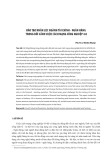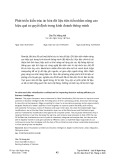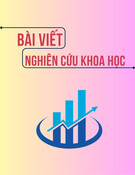
VNU Journal of Economics and Business, Vol. 4, No. 6 (2024) 62-72
62
Original Article
The influence of management commitment on digital and
green transformation in Vietnamese enterprises:
Empirical insights
Phan Hong Hai, Tran Ngoc Hung*
Industrial University of Ho Chi Minh City
No. 12, Nguyen Van Bao Street, Ward 4, Go Vap District, Ho Chi Minh City, Vietnam
Received: October 09, 2024
Revised: December 06, 2024; Accepted: December 25, 2024
Abstract: This study explores the multifaceted impact of digital transformation and green initiatives
on Vietnamese enterprises, explicitly focusing on the critical role of managerial commitment to
information technology. Digital transformation, a catalyst for reshaping operations, strategies, and
competitive dynamics, integrates digital technologies into various business aspects. The study
investigates key determinants impacting digital transformation and green initiatives: information
technology infrastructure, managerial commitment, competitive intensity, employees’ digital
competencies, and strategic orientation. Utilising Partial Least Squares Structural Equation
Modeling (PLS-SEM), the study analyses data from 200 enterprises, highlighting the significant
positive effects of these factors on digital transformation and subsequent green initiatives. The
findings reveal that managerial commitment and employee digital skills are foundational for
successful digital transformation, while competitive intensity and strategic orientation drive green
initiatives. This study underscores the necessity of proactive digital managerial and strategic
alignment for fostering sustainable and competitive business environments in the digital era.
Importantly, it provides practical implications for Vietnamese enterprises, equipping them with
actionable insights to navigate the digital and green transformation landscape.
Keywords: Competitive intensity, digital transformation, information technology, green
transformation, managerial commitment, strategic orientation.
1. Introduction*
Digital transformation (DX) represents a
complex and multidimensional process that
influences various dimensions of organisations.
________
* Corresponding author
E-mail address: tranngochung@iuh.edu.vn
https://doi.org/10.57110/vnu-jeb.v4i6.342
Copyright © 2024 The author(s)
Licensing: This article is published under a CC BY-NC
4.0 license.
Multiple factors significantly influence the
effectiveness and outcomes of DX drives.
Research demonstrates that DX significantly
improves organisational agility, facilitating
more efficient and adaptive allocation of
Licensing: This article is published under a CC BY-NC
4.0 license.
Copyright © 2024 The author(s)
Licensing: This article is published under a CC BY-NC
4.0 license.
VNU Journal of Economics and Business
Journal homepage: https://jeb.ueb.edu.vn

P.H. Hai, T.N. Hung / VNU Journal of Economics and Business, Vol. 4, No. 6 (2024) 62-72
63
resources (Priyono et al., 2020). The
achievement of DX is significantly influenced
by the strategic roles of information technology
(IT) and, critically, the commitment
demonstrated by managers. Leadership
commitment is critical in driving successful DX,
sectoral relevance and other critical drivers (Ko
et al., 2022). The literature identifies four
overarching strategies for DX, each differing in
leadership style, the importance of skills, risks
and challenges, and the consequences of
potential failure. Furthermore, DX can
significantly enhance international trade,
influence geopolitical dynamics, optimise
supply chain efficiency, and improve access to
digital services (Font-Cot et al., 2023).
The DX of human resource management is
propelled by the evolving digital needs of
internal stakeholders, advancements in industry-
specific digital innovations, competitive
pressures, digital innovation governance, and the
digital age’s overarching demands (Zhang &
Chen, 2024). Strong leadership from top
management and robust policy support are
essential for facilitating DX within construction
enterprises (Zhang et al., 2023). Moreover,
effective management of proactive DX strategies
and the swift execution of these initiatives are
essential for ensuring the successful DX of
organisations (Laorach et al., 2022). The impact
of DX on the competitiveness of small and
medium enterprises has also been explored,
emphasising the need for a systematic approach
to assess the effectiveness of DX (Medennikov,
2020). The success of DX is determined by
individuals' proficiency in digital knowledge and
skills, the specific DX model implemented, and
the identification and management of critical
success factors. Challenges such as resource
limitations and human capital's strategic
management are critical factors organisations
must address. DX is a critical driver for advancing
the digital economy nationally and globally
(Petrova et al., 2022).
To understand the impact of DX on green
transformation (GX), it is crucial to examine the
interaction between these phenomena. Research
shows that DX significantly enhances green
innovation within enterprises. Studies have
found that DX can boost high-quality green
innovation, particularly in high-tech and state-
owned companies, by easing financing
constraints and enhancing corporate governance
(Feng et al., 2022). DX has also been shown to
improve green resilience, especially in resource-
based provinces, underscoring its positive
influence on environmental sustainability (Wang
et al., 2024).
The integration of DX with green innovation
has been investigated, revealing that digital
technologies can notably enhance green
technology innovation by alleviating financing
constraints and attracting government subsidies
(Xue et al., 2022). This integration is essential
for improving green technology innovation
within organisations and advancing sustainable
development goals (Xie et al., 2023). Additionally,
the mediating role of DX in optimising resource
allocation to promote green technological
innovation has been explored, emphasising the
importance of leveraging digital tools for
environmental sustainability (Liu et al., 2024).
The impact of DX on GX extends beyond
innovation to encompass environmental
performance and sustainability. Studies have
indicated that corporate DX positively affects
environmental performance by enhancing total
factor productivity, fostering green technology
innovation, and optimising corporate
governance structures (Xue et al., 2022). This
underscores the broader implications of DX in
promoting green development and sustainability
within organisations.
Vietnam's digital and green transitions are
increasingly recognised as critical pathways for
sustainable development. Research indicates that
integrating digital technologies into various
sectors, including agriculture, healthcare, and
supply chains, enhances efficiency and
sustainability. For instance, a survey revealed
that while the adoption of Industry 4.0
technologies is still low among Vietnamese
supply chain firms, there is significant potential
for digital technologies such as the Internet of
Things (IoT) to improve supply chain
sustainability (Akbari & Hopkins, 2022). This
transition is supported by various policies that
foster green investments and sustainable
practices across sectors. The literature highlights
the importance of growing digital enterprises
and digitalising traditional businesses in
Vietnam's digital economy. This entails the
integration of digital technologies into products,
the transformation of business models into

P.H. Hai, T.N. Hung / VNU Journal of Economics and Business, Vol. 4, No. 6 (2024) 62-72
64
digital platforms, and the modification of
production processes through the utilisation of
digital data, automation, and virtualisation
(Hang et al., 2021). Research suggests that
administrative reforms at the provincial level in
Vietnam can have the potential to enhance
operational efficiency significantly and
competency through DX strategies and that DX
and administrative reforms should be pursued
concurrently for optimal results (Thanh, 2021).
2. Literature review
2.1. The role of IT and DX
The pivotal role of information technology
(IT) in DX cannot be overstated, as it profoundly
influences organisational structures, routines,
information flow, and the ability to adapt to new
technologies. DX is an ongoing process
involving adopting emerging digital
technologies, where agility is recognised as a
pivotal mechanism for strategic renewal,
influencing an organisation’s business model,
collaborative practices, and cultural dynamics
(Warner & Wäger, 2019). IT infrastructure's
impact on an enterprise's DX is indirect, with the
DX strategy serving as a full mediator (X. Zhang
et al., 2023). This mediation highlights DX's role
in linking relational and cognitive embeddedness
to enterprise performance, emphasising its
complex relationship with organisational dynamics
(Li & Fei, 2023). It substantially strengthens
corporate innovation and absorptive capacity, with
absorptive capacity serving as a mediating factor in
the relationship between DX and corporate
innovation (Wang, 2022). DX's connection to
digitalisation demonstrates how organisations use
digital initiatives to improve organisational
workflows and create customer value,
underscoring its importance in shaping the modern
business landscape (Marks & Al-Ali, 2022).
H1: The role of IT positively impacts DX.
2.2. The managerial commitment and DX
Managerial commitment is crucial for
successful DX. It is a significant moderating
factor in the relationship between IT
infrastructure and DX strategy, as well as
between DX strategy and organisational
performance (Zhang et al., 2023). This
underscores the critical importance of proactive
engagement and unwavering support from top
management in facilitating and advancing DX
initiatives. Factors related to organisational
commitment significantly impact business
performance during DX, underscoring the vital
significance of commitment in attaining
successful outcomes (Phuong et al., 2023).
Moreover, digital leadership impacts innovation
management by fostering dynamic capability,
emphasising the importance of leadership in
driving innovation within DX contexts
(Mihardjo et al., 2019). The broader
organisational implications of DX, such as its
effect on lean production systems and supply
chain management, highlight the essential role of
managerial commitment in integrating and
tailoring digital technologies for optimisation
within production and supply chain processes.
Additionally, research on small and medium-
sized ports within the TEN-T network highlights
the necessity of enhancing managerial capacity
in environmental accountability and digital
efficiency, emphasising the pivotal role of
managerial commitment in fostering sustainable
and digitally integrated port service ecosystems
(Gerlitz & Meyer, 2021).
H2: The managerial commitment positively
impacts DX.
2.3. The competitive intensity and DX
Competitive intensity plays a multifaceted
and significant role in DX, influencing various
dimensions of organisational performance and
strategic positioning. The literature indicates that
competitive intensity significantly influences the
perceived benefits of DX, with evidence
suggesting that competitive pressure positively
enhances the perceived advantages of DX,
particularly within the textile industry (Tsai &
Su, 2022). This intricate interaction between
competitive forces and the advantages of DX
initiatives underscores the critical necessity for
organisations to embrace digital innovation as a
means of adaptation. The impact of DX on the
competitiveness of small and medium-sized
enterprises (SMEs) in the agro-industrial sector
underscores its critical role in strengthening
competitive advantages within highly dynamic
and challenging market environments
(Medennikov, 2020). Furthermore, DX's role in
mitigating financial risk is more pronounced in

P.H. Hai, T.N. Hung / VNU Journal of Economics and Business, Vol. 4, No. 6 (2024) 62-72
65
competitive industries, enhancing organisational
resilience and stability amid intense market
dynamics (You & Zhao, 2023). The impact of
DX on sustainable supply chain management
and organisational sustainability highlights its
potential to enhance sustainability practices and
competitive advantage (Stroumpoulis &
Kopanaki, 2022). In conclusion, competitive
intensity significantly impacts DX, shaping
organisational strategies, competitive
positioning, and sustainability efforts,
highlighting the strategic need for leveraging
DX in dynamic market environments.
H3: The competitive intensity positively
impacts DX.
2.4. The digital knowledge and skills of
employees and DX
Employee digital competencies are essential
for achieving successful DX. Existing research
underscores the critical influence of employee
knowledge and skills on the DX process,
highlighting their pivotal role in addressing the
complexities of digitalisation and enhancing
organisational preparedness for the digital era.
DX is an ongoing process that requires agility
and the development of dynamic capabilities,
with employee knowledge and skills
instrumental in adapting to new technologies,
reshaping business models, and fostering a
collaborative culture (Warner & Wäger, 2019).
Acquiring digital knowledge and competencies
is crucial for effectively implementing DX
strategies, as transformational insights depend
on employees’ development and application of
digital competencies (Matt et al., 2015).
Moreover, employee intentions to learn and
adopt digital technology play a significant role,
with findings underscoring the importance of
understanding these intentions and challenges in
embracing digital technology (Chaudhuri et al.,
2023). The COVID-19 pandemic further
highlighted the need for employees to acquire
new digital competencies, emphasising
organisational investment in developing their
workforce's digital skills to navigate DX
challenges (Bikse et al., 2021).
H4: The digital knowledge and skills of
employees positively impact DX.
2.5. The strategic orientation and GX.
Strategic orientation, mainly green
entrepreneurial orientation, is crucial for driving
green innovation and improving environmental
performance (Makhloufi et al., 2021). Studies
show that strategic green orientation fosters
innovation and collaboration among firms,
improving green performance outcomes (L. Li et
al., 2018). Moreover, strategic organisational
orientation is vital for implementing green
supply chain management practices and
enhancing firm sustainability performance
(Habib et al., 2021). The digital economy, as part
of DX, contributes significantly to green
development and the quality of green innovation
in enterprises (Huang, 2024), with its
environmentally friendly characteristics
propelling industrial GX (Wang et al., 2024).
Integrating DX with supply chain management
practices enhances green design and
manufacturing processes (Minh et al., 2023).
H5: The strategic orientation positively
impacts GX.
2.6. The competitive intensity and GX
The relationship between competitive
intensity and green transformation can be
understood through various mechanisms,
including the influence of market pressures,
corporate social responsibility (CSR) initiatives,
and adopting sustainable practices. Firstly,
competitive intensity can drive firms to adopt
more environmentally friendly practices to
differentiate. This competitive pressure can
improve environmental performance as
companies recognise the potential for green
initiatives to enhance customer loyalty and
market share (Gani, 2023). Moreover, the
intensity of competition can influence the
strategic orientation of firms towards
sustainability. In environments characterised by
high competitive intensity, firms may prioritise
sustainable manufacturing practices to gain a
competitive edge. Adopting green practices can
enhance operational capabilities and improve
sustainable performance, reinforcing the firm's
competitive position in the market. This is
particularly relevant in sectors where consumers
increasingly demand sustainable products and

P.H. Hai, T.N. Hung / VNU Journal of Economics and Business, Vol. 4, No. 6 (2024) 62-72
66
practices, prompting firms to innovate and invest
in green technologies (Chen & Liu, 2018).
H6: The competitive intensity positively
impacts GX.
2.7. The DX and GX
Digital transformation significantly shapes
green transformation by bolstering
organisations’ capabilities in sustainable
innovation, operational efficiency, and
regulatory compliance. Digital technologies
such as big data, artificial intelligence, and cloud
computing facilitate developing and
implementing advanced green solutions.
Moreover, digital transformation enhances
information flow and corporate governance,
which is crucial for environmental sustainability.
Streamlined communication and decision-
making processes enable firms to address
environmental challenges and meet regulatory
requirements more efficiently (Xie, 2023). The
interplay between digital transformation and
regulatory frameworks further catalyses green
innovation. Firms in regions with stringent
environmental regulations must adopt digital
solutions to ensure compliance while fostering
innovation. This "Porter compensation effect"
demonstrates how regulatory pressures drive
firms to integrate digital transformation for
competitive advantage in sustainability (Chen,
2024).
H7: The DX positively impacts GX.
Based on the eight hypotheses mentioned
above, the theoretical framework was built as
below:
Figure 1: Overview of the theoretical framework
Source: Authors’ own work.
3. Methodology
The study population comprises enterprises,
approached using a simple random sampling
method. To gather feedback from accountants,
chief accountants, CFO, CEO, and managers of
other operational departments in these
enterprises, 350 questionnaires were distributed.
Of these, 231 valid responses were received,
resulting in a response rate of 66%. After data
cleaning, 200 responses were analysed using
SmartPLS 4.1.0.0 software.
The study examines the relationship between
four independent variables and the dependent
variable, DIGI (Digital Transformation),
utilising the following model:
DIGIi = α + β1ROITi + β2MANAi+ β3COMPi
+ β4KNOWi + ε,
The study examines the relationship between
three independent variables and the dependent
variable, GREEN (Green Transformation),
utilising the following analytical model:
GREENi = α + β5COMPi + β6STRAi +
β7DIGIi + ε,
Where:
- DIGIi stands for Digital transformation
- GREENi stands for Green Transformation
- α: constant term
- βi: coefficient of variables
- εi: Residual
Role of IT
Management
commitment
Strategic
orientation
Digital
knowledge
Competitive
intensive
Digital
transformation
Green
transformation


























